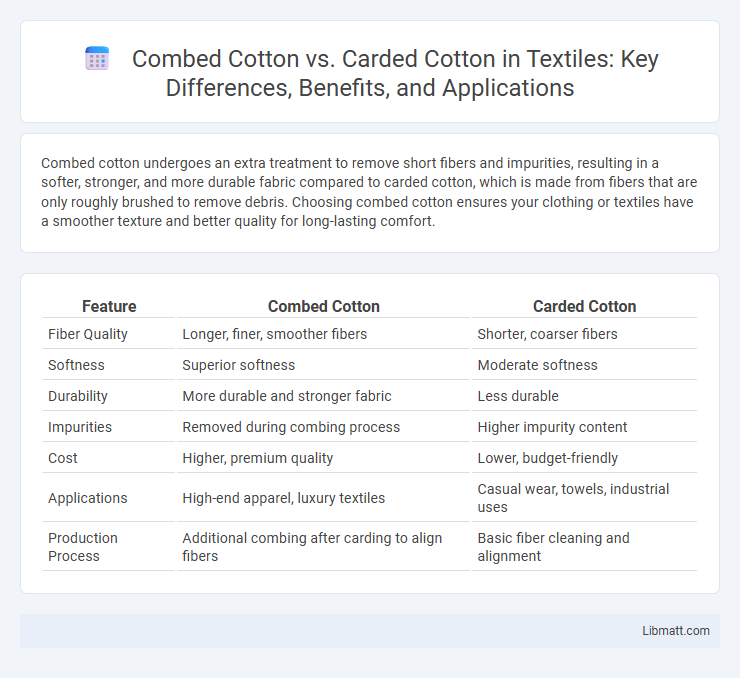Combed cotton undergoes an extra treatment to remove short fibers and impurities, resulting in a softer, stronger, and more durable fabric compared to carded cotton, which is made from fibers that are only roughly brushed to remove debris. Choosing combed cotton ensures your clothing or textiles have a smoother texture and better quality for long-lasting comfort.
Table of Comparison
| Feature | Combed Cotton | Carded Cotton |
|---|---|---|
| Fiber Quality | Longer, finer, smoother fibers | Shorter, coarser fibers |
| Softness | Superior softness | Moderate softness |
| Durability | More durable and stronger fabric | Less durable |
| Impurities | Removed during combing process | Higher impurity content |
| Cost | Higher, premium quality | Lower, budget-friendly |
| Applications | High-end apparel, luxury textiles | Casual wear, towels, industrial uses |
| Production Process | Additional combing after carding to align fibers | Basic fiber cleaning and alignment |
Introduction to Cotton Processing Techniques
Combed cotton undergoes an extra step in processing where fibers are carefully aligned and shorter fibers removed, resulting in a smoother, stronger, and more durable fabric compared to carded cotton. Carded cotton fibers are disentangled and roughly aligned using wire brushes, producing a fabric that is softer but less refined and prone to pilling. Your choice between combed and carded cotton depends on the desired texture, durability, and quality for clothing or textile applications.
What is Combed Cotton?
Combed cotton is a superior quality cotton fabric created by a process that removes short fibers and impurities, resulting in a smoother, stronger, and more durable material compared to carded cotton. This meticulous treatment enhances softness and reduces pilling, making it ideal for premium clothing and textiles. Your garments made from combed cotton will offer greater comfort and longevity in everyday wear.
What is Carded Cotton?
Carded cotton undergoes a mechanical process where raw cotton fibers are brushed and aligned to remove impurities and short fibers, resulting in a coarser, less uniform texture compared to combed cotton. This method retains more fibers but produces a fabric that is slightly rougher and less durable, making it ideal for affordable and everyday textiles. Your choice between carded and combed cotton depends on the desired softness, strength, and cost-effectiveness of the fabric.
Key Differences Between Combed and Carded Cotton
Combed cotton undergoes an additional process where short fibers and impurities are removed, resulting in a smoother, stronger, and softer fabric compared to carded cotton, which uses a simpler cleaning method retaining more fiber irregularities. The finer fiber alignment in combed cotton enhances durability and comfort, making it ideal for high-quality garments and bedding. Your choice between combed and carded cotton influences fabric softness, strength, and overall product longevity.
Fiber Quality: Softness and Strength
Combed cotton fibers undergo an additional process that removes shorter strands and impurities, resulting in finer, softer, and stronger fabric compared to carded cotton. This enhanced fiber quality provides exceptional durability and a smooth texture, ideal for sensitive skin and long-lasting garments. Choosing combed cotton ensures Your textiles achieve superior softness and tensile strength, elevating overall comfort and wearability.
Durability and Longevity
Combed cotton undergoes a meticulous process that removes short fibers and impurities, resulting in stronger, more durable fabric compared to carded cotton, which contains a mix of cotton fibers including shorter ones. The enhanced strength of combed cotton increases its longevity, making garments resistant to wear and tear over extended use and multiple washes. Choosing combed cotton ensures your clothing maintains softness and structural integrity longer than carded cotton alternatives.
Cost Comparison: Combed vs Carded Cotton
Combed cotton typically costs more than carded cotton due to its additional processing that removes short fibers, resulting in a smoother and stronger fabric. Carded cotton is less expensive because it undergoes a simpler cleaning process, retaining more fiber impurities and irregularities. Your choice depends on whether you prioritize cost savings with carded cotton or higher quality and durability offered by combed cotton.
Best Uses for Each Cotton Type
Combed cotton offers superior softness and strength, making it ideal for high-quality apparel like T-shirts, underwear, and luxury bedding. Carded cotton, being less processed, is best suited for durable products such as towels, denim, and inexpensive textiles where softness is less critical. Choosing the right cotton type enhances fabric performance based on the intended use, balancing comfort and durability.
Environmental Impact and Sustainability
Combed cotton undergoes an extra process that removes impurities and short fibers, resulting in higher-quality fabric but increases water and energy usage, impacting its environmental footprint. Carded cotton requires fewer resources and less processing, making it a more sustainable option with lower carbon emissions and water consumption. Choosing carded cotton supports eco-friendlier textile production by minimizing waste and reducing the overall environmental impact compared to combed cotton.
How to Choose the Right Cotton for Your Needs
Combed cotton offers a smoother, stronger fabric by removing short fibers and impurities, making it ideal for premium clothing and sensitive skin. Carded cotton retains more fibers and has a slightly rougher texture, providing a cost-effective option suited for everyday wear and household textiles. Consider durability, softness, and budget requirements to select the most appropriate cotton type for your specific use.
Combed cotton vs Carded cotton Infographic

 libmatt.com
libmatt.com